
In this effort we will attempt to
assess the validity of imaging data relating to the purported entrance to the
"Martian Glass Tunnel System" which was posted on Johnny Danger's Dangerous
Mars Site. As other credible researchers have speculated profusely on the nature
of these "tunnel like\tubular anomalies" we will not reiterate their notions
or add to the confusion with additional conjecture (however, some degree of
speculation is inevitable due to the subject matter).
Our intent is to examine the MGS ancillary data related to the imaging of this
area on Mars as utilizing several proven, reliable image analysis techniques
in an attempt to discern the true nature of this unusual image and several geographically
adjacent anomalies found in the vicinity.
The original source for the image under analysis is MOC image M1501228.
I will further preface this
analysis with this disclaimer. I am a layperson who has, as a hobby, taken an
interest in Martian anomalies. It has been very educational as well as entertaining.
I am not a professional scientist, collegiate researcher or imaging expert.
I will not benefit from any financial gain from the dissemination of this information.
That being said, I've done my best to utilize the God given natural ability
and talent I've been blessed with to understand and analyze this data in a thorough
and impartial manner (with an enormous amount of help from others for which
I cannot adequately express my appreciation.)
Any errors or omissions are the results of this authors unfamiliarity with this
"rocket science" and are not a deliberate attempt at duplicity.
I merely seek the truth and a better understanding of the universe we exist in.
The Official JPL Explanation
David
C. Pieri, Ph.D. Earth and Space Sciences Division of the Jet Propulsion
Laboratory has postulated that the "Martian Glass Tunnel Anomalies" are nothing
more than simple Martian dune trains. I am not acquainted with Dr. Pieri and
have no intention of impugning his reputation. He is after all a respected planetary
scientist with years of experience in the field, and I am merely an individual
with an interest in these subjects. Dr. Pieri makes an excellent point that
the interpretation of satellite imagery can be ambiguous, especially for those
individuals untrained in remote sensing applications.
We believe that Dr. Pieri's judgment of these anomalies, based on only one image
which was posted on Richard C. Hoagland's Enterprise Mission website, may have
been premature. Additional data in the form of images from the Mars Global Surveyor
has been located and would seem to support the hypothesis that these unusual
features are something far more interesting and enigmatic than a mere sand dune.
You may wish to read our earlier
analysis of MOC image M1501228d (http://www.geocities.com/photon9999/Analysis2.htm)
which addresses the apparent dichotomy between "Martian Dune Trains" and "Martian
Glass Tunnel Anomalies". First let's revisit an image from our last installment.
Shown here is an actual Martian dune train image from the Malin Space Science
Systems image repository. A link to the original image is provided below.

Image of Martian Dune Train
http://www.msss.com/Mars_images/moc/june2000/gorgonum/gorgonum2_c100.jpg
The Anomalous Image
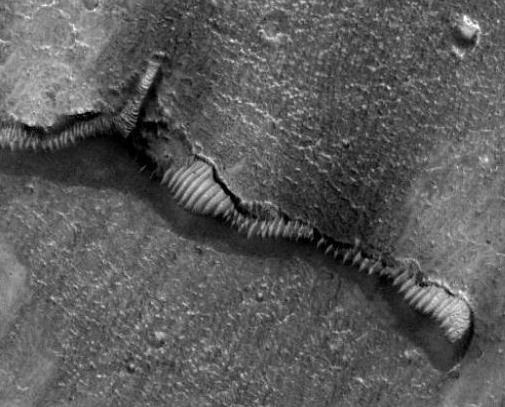
In this composite image we have
taken the portion of MOC image m1501228a that is immediately adjacent to MOC
image m1501228b and created a single image in hopes that it will help further
our analysis and as well as to simply see the "big picture". (Mr. Danger undoubtedly
thought that the flat spot on the top of the humanoid head was an area for the
convenient storage of a six pack of his favorite beverage! Not so, Mr. Danger!:)
Just above "Grand Central" in MOC Image M1501228a one can spot an additional
incongruity in the appearance of an unusual object that we will visit further
along in this piece.
Mr. Danger's "Grand Central Station of Mars" image can be seen immediately below.

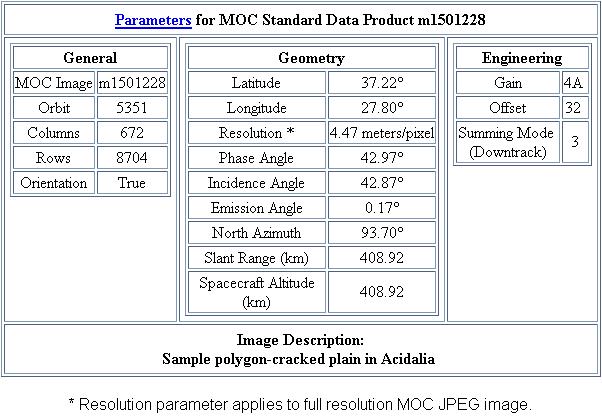
Mars Global Surveyor Parameter Descriptions
Rather than hyperlink to or append these parameter definitions I have chosen to post these here to illustrate the daunting task faced by the layperson when attempting to foray into the bailiwick of "rocket scientists". Thanks to all those folks whose infinite patience with my seemingly endless questions enabled this analysis to be realized.
Interpreting the data for MOC
Image m1501228b
While all the pertinent data is important to interpretation of MGS images, we are most interested in the parameters for Resolution, Incidence Angle, Emission Angle, Slant Range and Spacecraft Altitude.
The incidence angle (42.87) is the angle of the sun from directly overhead. The complement (about 47 degrees) is the elevation angle above the horizon. The azimuth is 298.93, which means that the sun is about 29 degrees to the right of the top of the image.
Basically, the image is illuminated
from the upper right.
This is helpful because it allows one to reasonably extrapolate or interpret
the formation of shadows for a three dimensional construct this scope.
Now let's look at Emission angle,
Slant range and Spacecraft altitude as a single entity. The Emission angle is
0.17 degrees and is (I assume-correct me if I'm wrong here) a function of Slant
angle and Spacecraft altitude.
As the Slant angle and Spacecraft altitude are both listed as 408.92 Km the
spacecraft was directly overhead at the time of imaging. (Another assumption-the
small emission angle is the product of rounding errors or truncated decimal
values of the aforementioned parameters-thus it's not equal to zero.)
This virtually eliminates the possibility of pixel stretching or optical illusions
incurred by imaging done at an oblique angles.
Resolution and it's pertinence is discussed below in the physical dimensions section.
Clearly, under the given imaging conditions, one can virtually eliminate the the possibility that this is a "trick of light and shadow" (TOLAS).
In layman's terms,
"What you see is what you get".
Physical dimensions
Bear in mind that these numbers are not a direct corollary to actual dimensions as in a 2D image. There are components of height, width and breadth that cannot be easily delineated from one another without applying precise trigonometric functions to an accurate topographical survey. Still , they are indicative of the enormous mega-scale of this anomaly.
The resolution for this image is 4.47 meters\pixel. By utilizing any number of commercially available imaging programs we can count the number of pixels in height and width of a particular feature and multiply that number by 4.47 to estimate the approximate size in meters of the feature being analyzed.
At a scale of 4.47 meters\pixel
a quick pixel count in Photoshop yields a height of approxomately 74 pixels
(top of Forehead) by a width of approximately 41 pixels (width of humanoid head).
This tranlates to approximately 331m high by 183m wide (1085 feet by 600 feet).
The overall distance from the "water" to the top of the head is approximately
1920 feet. The entire anomaly (humanoid and fish sculpture) is approximately
131 pixels high by 88 pixels wide or 585m by 393m (1920ft by 1289ft).
That would make this edifice around
three eighths of a mile high! A construct far larger than either Mt. Rushmore
and Crazyhorse in South Dakota or Stone Mountain in Georgia.

Image courtesy of Kevin Klettke and Eric C. Lausch
© 2001 Dangerzone Productions
The roof of the "tunnel" entrance to the right of the opening is approximately 50 pixels (733feet) across at the leftmost arrow location. If this is indeed the "roof" of a structure the area enclosed is enormous. The ribs of the tube at the two locations shown in this crop are 38 (557 ft)and 32 (469 ft) pixels respectively (left to right) at the arrow locations.
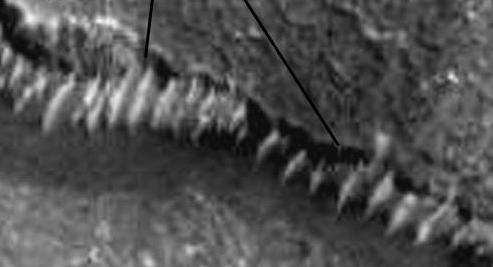
Image Courtesy of Kevin Klettke and Eric C. Lausch
© 2001 Dangerzone Productions
If, as postulated by JPL, these
ribs are the crests of a Martian dune train, I would be curious to know what
mechanism or geological process causes a sand dune to run 500 feet straight
up a vertical cliff? And how, if composed of sand, are we able to peer above
them into the darkness of the defile at the leftmost arrow and behind as well
as between them at second and third arrows?
It is beyond comprehension how anyone conducting an impartial investigation
could come to the conclusion that this structure is a simple dune train!
What possible reason could JPL and NASA have to dismiss such glaring anomalies
out of hand with an inadequate explanation such as the one publicly given by
a representative of JPL?
This author, for one, cannot fathom the reasoning behind such a lack of scientific curiousity.
After reviewing all the facts and data in regards to Mars anomalies we can reach no other conclusion than that these organizations for some reason do not examine the claims of Martian anomalies in a disciplined scientific manner when these unusual artifacts are presented by individuals outside of the planetary science community. It seems almost to be a threat response-fight or flight-when someone who is not a member of their exclusive club plays a trump card that they cannot counter. What possible impetus drives these organizations to dismiss out of hand or ignore the queries of the American taxpayer, who in effect, pays their salaries?
It defies the very nature
of noble ethics, good will and common sense that this nation and it's space
agency were founded upon.
Comparison to a terrestrial analogue
Below you will see an image of Mt. Rushmore which I have cropped and made into a greyscale (B&W image). The lighting conditions are similar to those found in MOC image m1501228b (the closest I could find), with the sunlight illuminating the structure from the upper right. Although our Martian anomaly is physically quite larger than our terrestrial counterpart, the analogy is still viable and surprisingly intriguing.

Mt. Rushmore
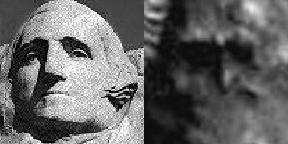
Terrestrial effigy compared to Martain effigy
© 2001 Dangerzone Productions
In this image we compare the sculpted
head of George Washington at Mt. Rushmore with this highly unusual Martian artifact.
Keep in mind the sun in both images is to the upper right. We see in this comparison
that the shadowing is consistent on both sculptures. Note the similarities of
shadowing on the left side of the nose and the left forehead continuing down
the length of the jaw line. Make special note of the shading at the right eye
socket. The shape cast by the shadows is almost identical in both cases.
Everything we see here is reasonably consistent with an incidence angle of 42.87
degrees as noted in the MGS Data table, illuminating these edifices from the
upper right of the images.
Below, we offer an additional image for comparison. Superimposed on the craggy shelf which overhangs the tube entrance are the four biggest guys in rock. Although woefully out of scale (the Rushmore faces are approximately 60 feet high), it helps define perspective on these huge carvings as the viewer becomes removed in distance from them. (I simply could not resist doing this!) This author sees a striking similarity between this image from Mars and what sculptor Gutzon Borglum intended to create when he began drilling into the 5,725-foot mountain in 1927. Perhaps we should start calling them the the four biggest Earth guys in rock!
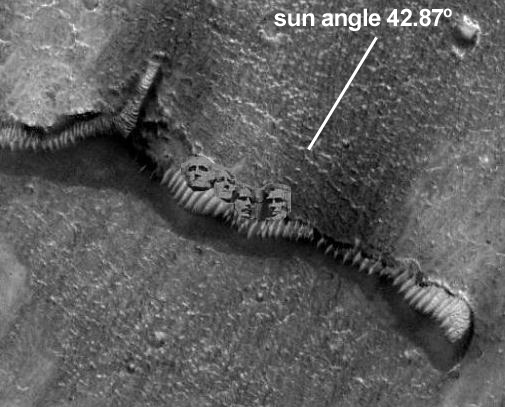
Image Enhancements by Kevin Klettke and Eric C. Lausch
© 2001 Dangerzone Productions
Colorization
Colorization is simply a method
of highlighting details in an image with some color in order to make them more
discernible. Sort of like separating the wheat from the chaff.

Image Enhancements by Kevin Klettke and Eric C. Lausch
Colorization by Keith Laney
© 2001 Dangerzone Productions
Here we offer two different colorizations
of the image crop of MOC m1501228b. They are simply another tool for illustrating
this unusual feature, shown side by side with a greyscale companion for comparison.
I was quite surprised to see how prominent the lips are in the image below.
They have not been added or drawn in in any way. They simply became much more
visible when color was added and opacity was manipulated. By scrutinizing the
greyscale image one can see that there are actually lips to be seen, barely
visble to the naked eye!

Colorization by Keith Laney
© 2001 Dangerzone Productions
Photoclinometry (Shape from Shading Anaysis)
Shape-from-shading (also known as photoclinometry) is a method for determining the shape of a surface from its image. For a surface of constant albedo, the brightness at a point (x,y) in the image is related to the gradients (p,q) by the following expression
i(x,y) = a R[p(x,y),q(x,y)]
where R is the reflectance map,
p = dz/dx and q = dz/dy are the partial derivatives of the surface in the x-
and y-directions, and a is a constant that depends on the albedo, the gain of
the imaging system and other factors. The above expression also assumes that
any additive offsets, e.g., due to atmospheric scattering, have been removed.
-Dr. Mark Carlotto
SFS article- http://www.psrw.com/~markc/Articles/SFS/sfs.html
However, We would be remiss not
to elucidate on the limitations of photoclinometry:
In an e-mail to Chris Joseph, who had inquired about photoclinometry and MOLA,
Lori Fenton, a grad student at CalTech describes the shortcomings of photoclinomtery.
"The worst problem with photoclinometry is that you can never tell by looking at an image, particularly on Mars where you can't go there and find out what you're really imaging, whether the shading effects are due to topography or change in albedo. Anything from compositional to textural changes can cause a change in albedo, and most photoclinometry programs assume that the albedo is constant across the image. Unfortunately there's no good way to figure out what the true pattern of albedo really is, and so you're stuck assuming that it is constant, but you have to keep this in mind when you solve for topography.
A slope that is dark because it is covered in dark volcanic ash will appear to tilt away from the sun, because photoclinometry will assume that all dark surfaces tilt away from the sun. When I did photoclinometry I used a surface that was covered in white seasonal frost, so the surface was likely more or less all the same albedo, and in addition I used other topographic techniques to compare with what I found. So my advice on how to separate albedo from topography is to add in other topographic data -- either from stereogrammetry or from MOLA. MOLA is the easiest way to go since you can just plot up the data -- and where MOLA disagrees with your photoclinometry work, you know you've got a change in surface albedo.
Atmospheric effects are difficult to account for, but they can seriously change your results. A uniform haze in the atmosphere will make the topography seem more subdued. Again, there's no really good way to account for this except by comparing your results with a MOLA profile, since MOLA mostly hits the ground rather than clouds."
-Lori Fenton, Caltech
Dr. Carlotto has commented in the
past that the change in albedo on the tubes has made them a poor candidate for
SFS due to the very reasons that Ms. Fenton discusses in her photoclinometry
papers.
However, the roof of this edifice appears to be of a uniform albedo, not alternating
area of bright and dark as we've observed in other images of these anomalies
where the bright "ribs" alternate with the darker tube walls.
The Martian Mega- Split Faced Glyph
also is fairly consistent in albedo. (If carved or constructed it stands to
reason the material composition at least on the exterior would be uniform and
have a fairly uniform albedo). The main changes are at the eye sockets, the
left side of the head and the mouth of the fish due to the lighting angle and
subsequent shadowing. Our
unofficial opinion as a lay person is that this image is a pretty good candidate
for photoclinometry!
Our first two SFS offerings were
processed using software known as the "Mars 3D Launcher". (It also
does MOLA datasets IF they are available.....)
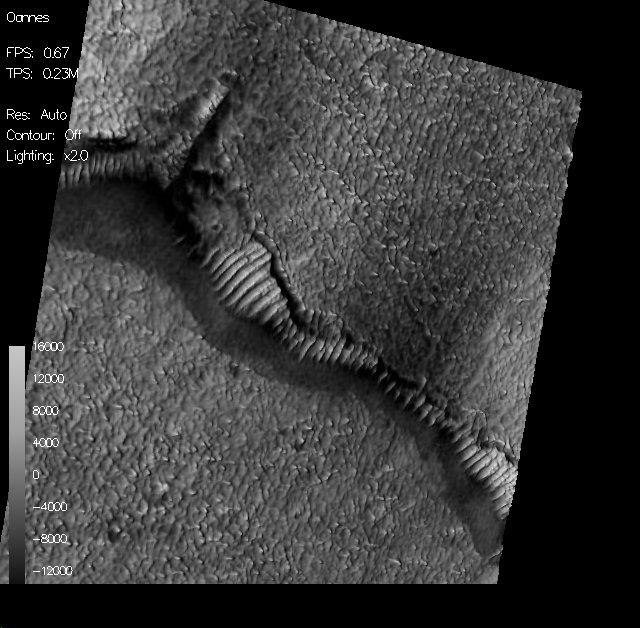
Shape from Shading analysis by Keith Laney
© 2001 Keith Laney and Dangerzone
Productions
In our estimation, these images are visually compelling evidence that this highly anomalous object on the planet Mars is no mere sand dune as postulated by JPL. This appears to be an intelligently designed edifice. And a strikingly beautiful one at that. Whether sculpted from native Martian rock or produced by some organic technology unbeknownst to our ilk, it fills me with wonder and curiousity.
Perhaps this is the kind
of awe ancient sojourners felt when gazing upon the Collossus of Rhodes or the
Hanging Gardens of Babylon for the first time.

Shape from Shading analysis by Keith Laney
© 2001 Keith Laney and Dangerzone Productions
The next SFS image was rendered
as a texture map using Bryce3D software. Here we see additional confirmation
of the three dimensional nature of this structure by a different imaging method.
While it does seem to corroborate the split-faced glyph there are two things
which I find utterly fascinating about this image.
The first is the roof of the enclosure. At this perspective you are basically
viewing it at an oblique angle. From this vantage point the structure seems
to fulfill the form, fit and function that one would expect in such an application,
analogous to what one would see at a sports colliseum or other large venue.
The relatively flat center section of the roof bounded by the curvatures of
the front and rear of the roof would seem to this author is indicative of a
fundamentally structural, designed element similar to that found in terrestrial
architecture. The escarpment which overhangs the roof is also clearly discernable.
The really amazing thing in this
image is the tunnels themselves. Just to the left of the humanoid sculpture
one can plainly see the curvature of the tube running in a generally north-south
direction away from this terminal under the surface of Mars. Moving from left
to right there appears to a series of these tubes parallel to the first all
leaving this main nexus in a perpendicular alignment. These are not readily
discernible in the 2 dimensional image.
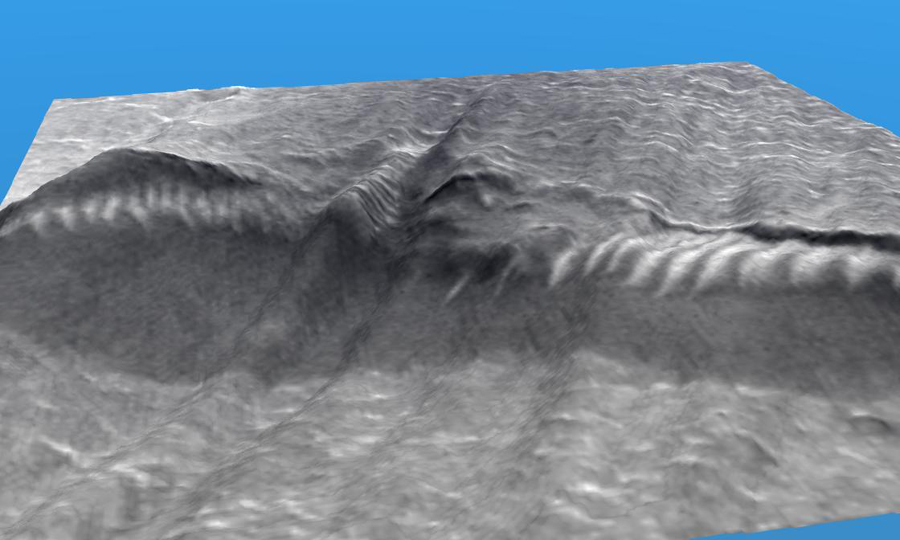
Shape from Shading analysis and texture mapping By Chris Joseph
© 2001 Christopher Joseph and
Dangerzone Productions
MOLA DATA Interpretation
(Mars Orbiter Laser Altimeter)
After a valiant (and frustrating)
effort at ferreting out the MOLA data archived in a morass of web databases
known as the the Planetary Image Atlas, we were dissapointed to find out that
this data is not available. MOLA data for MOC image m1501228 is presently (conveniently)
undergoing a peer review process and one assumes it will be available for dissemination
upon completion of the peer review process. We remain hopeful that this information
will be made available to the American taxpayer and the world scientific community
at the earliest possible date.
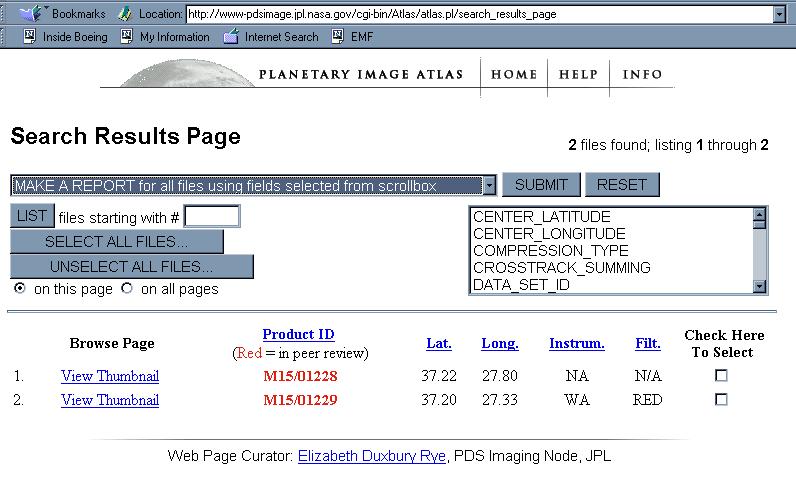
Planetary Image Atlas webpage denoting MOLA Data in peer review (as shown in
red lettering).
We were quite dissapointed
at the lack of availability of the pertinent MOLA data as it is required for
comparison to the photoclinometry analysis. We will process and post the results
of this data when it becomes available.
An e-mail note to web curator for the archive requesting an ECD for peer review
completion has at the time of this writing produced no response.
How ironic that the very data needed to corroborate the photoclinometry results
is being not made available to the American taxpayer who funds these projects.
Apparently there is documentation that shows this is not the first time that
NASA\JPL\MSSS have played
less than scrupulous games with MOLA data.
Mr. Danger is of the opinion that his posting of this image is the cause for the data not being available. The image and MOLA data were obtained in May, 2000. While this does seem like an inordinantly long period for peer review I'd chalk it up to the inefficiency of the Jet Propulsion Laboratory to accomplish their tasks in a timely manner.
The recent debacles
of the past few years at JPL even spawned a series of articles on Space.com
which portray JPL as a poorly managed leaking ship adrift in an ocean of organizational
chaos. While we doubt a conspiracy is being promulgated we would appreciate
a timely response and clear answer as to when this data will become available
to the American public whose daily toil finances ventures such as this.
Stereo pairings
The way these work is the left picture is on the right, and right on left... they are actually "taken" about 5 degrees off from each other, and provide the parallax (view) you need to see 3 dimensions. Relax your focus and let your eyes cross until it looks like there are three images. The one in the center should be 3D, like Tom Corbett on ViewMaster. It is essentially the same process used to make 3D images with those red and blue glasses that came with 3D comic books when we were kids, except that it uses no color (thus requiring no 3D glasses). (I actually physically cross my eyes to view these. It works quite well and they haven't gotten stuck that way-yet!)
The following was created by making
a Bryce2/3D/4 scene into true 3D Stereo image. Images that will appear to float
inches in front of (or behind) your monitor screen! In fact the basic technique
can be applied to any images that consist of seperate left and right eye views;
be they photographs, drawings or computer generated imagery. These are real
3D stereo images (anaglyphs). When the two images are then merged into a single
image, the left eye will see only the right image and the right eye the left
image. Because of the offset between the left/right images the brain interpets
the 'depth' giving the viewer the impression of a true 3D image.
A tutorial on the process can be found at http://www.landshapes.btinternet.co.uk/Pages/tutorials/tut_stereo/tut2.htm

Stereo Pairing By Chris Joseph
© 2001 Christopher Joseph and
Dangerzone Productions
Reflections on liquid water
Quoting a recent article from Spaceflight Now:
"In a paper published in a recent
issue of the journal Nature, University of Arizona hydrologist Victor Baker
concludes that, rather than being cold and dry for most of the last 3.9 billion
years, liquid water and ice has shaped the surface of Mars within the last 10
million years.
Baker points to several lines of evidence in support of his claim. For example,
MGS images of the planet's northern plains and southern highlands shows regions
relatively free of craters, implying they were altered in the recent past. These
regions also have a polygonal terrain that is similar to what is seen in permafrost
regions on Earth.
Baker thinks that Mars may go through cycles of extended cold, dry periods punctuated
by warmer, wetter spells. While the cold periods can last hundreds of millions
of years, the warmer periods may last just a few tens of thousands of years.
Moreover, Baker believes that there may be cold interludes within those brief
warmer periods, and that Mars today may be in such a brief cold period.
"We don't know the answer to that yet -- that's very speculative," he said.
"But if it's true, it would have major implications for sending people to Mars,
because it may mean that water is more available than otherwise thought."
The warm periods are triggered, Baker believes, by a period of massive volcanic
activity. The heat from that activity melts ice trapped below the surface, possibly
enough to form a temporary ocean in the planet's northern region. A greenhouse
effect created by carbon dioxide released into the atmosphere through the volcanic
activity warms the atmosphere and allows water to remain in liquid form at the
surface."
The south polar ice cap has been shrinking
steadily during the mapping phase of the MGS mission.
This same TES (Thermal Emission Spectrometer) data shows that from 45íS and
60íS latitude "Zonally averaged daytime bolometer brightness temperatures" of
23íC at 45íS! That's right! A balmy 73 degrees Farenheit! (Might as well be
Miami in January!)
In layman's terms, "Warm enough for liquid water to be found on the surface of Mars!"
If Baker is right Mars could be entering into one of it's warm phases at this very moment.

Image Courtesyof Kevin Klettke and Eric C. Lausch
Colorization by Keith Laney
© 2001 Dangerzone Productions
Unusual craters in the vicinity

Image courtesy of Eric C. Lausch
© 2001 Dangerzone Productions
Geologic and tectonic history
: The geologic and tectonic history of the Tharsis region -- the area
in which the suspected reservoir sits -- provides a possible explanation for
the localized concentration of ice and water, the team reported. Long-term activity
in this region would have tilted the water table, pooling the material in the
topographic low of Solis Planum.
"Heat associated with Tharsis may have maintained deep volatiles as liquid for
a longer time period than elsewhere in the Martian equatorial region," the team
reported. This unusual near-surface ice-reservoir may be easily accessible given
its depth of around 360 feet (110 meters). "The next stage of this study will
be to look at reasonable values of porosity and water concentrations to gain
a better understanding of how much ice and water may actually be contained within
this reservoir," Barlow said.
rime: white, opaque, granular deposit of ice crystals formed on objects that are at a temperature below the freezing point.
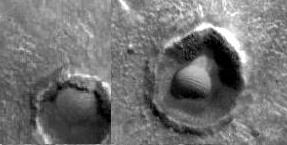
Domes in craters from M1501228d and M1501228a
© 2001 Dangerzone Productions
Comparison of crater domes from M1501228d and M1501228a
Graphic by Chris Joseph
© 2001 Christopher Joseph and Dangerzone Productions
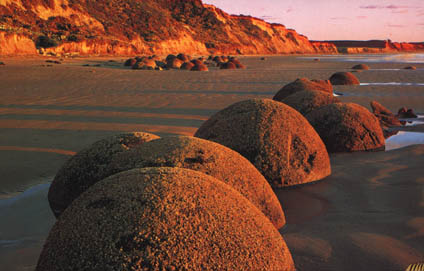
Spherical boulders on the New Zealand Coast
In this author's opinion the the geographically adjacent locations of the "Glass Tunnel" anomalies and "Crater Dome" anomalies is more than mere coincidence and must be related in some manner. It is ironic that the planetary science community is apparently not interested in further investigation of items of such monumental proportion and unusual characteristics.
Although this is
not the proper forum for speculation of this nature- we would be remiss not
to mention the possibility that this could be the product of some technology
rather than a naturally occurring entity. If the the "Glass Tunnels"
are indeed for water recirculation as some (including myself) have speculated
then perhaps this is some type of filtration\purification facility or possibly
a domed arcology that would fill Buckminster Fuller with wonder.
The most efficient geometric shape is a sphere as it uses the smallest surface
area to enclose a given space. It is interesting to note that the basic structural
unit of most Earthly geodesic domes is the tetrahedron. As geodesic domes require
no internal columns for support, these self-supporting structures make an excellent
choice for venues reqiuring unobstructed interior space.
At a little over
one tenth of a mile in diameter in Mars 40% of Earth gravity our "crater dome"
anomalies would experience a pronounced lifting effect.
It would seem a reasonable hypothesis to conclude that this effect may be the
cause for the difference in elevation between our two "crater dome" anomalies,
if one can verify that they are indeed hollow and that there is sufficient temperature
differential to create this lifting effect. As for the reasons behind this possible
temperature variation one can only speculate. The possibilities range from
geothermal activity to Martian machinery.
But such speculation
is best left to the likes of Johnny Danger and his cohorts.
The rest of us will just have to wait until the ESA Mars probe targets it's
ground penetrating radar and infrared camera at these unusual features on the
surface of Mars.
3D and Stereo Analysis of the "Crater Dome" Anomalies
(note: Remember to cross your eyes!)
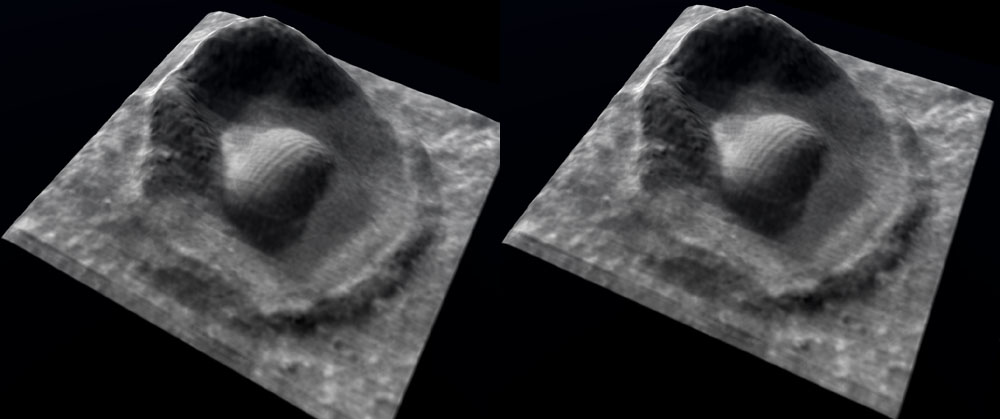
3D rendering of crop from M1501228a by Chris Joseph
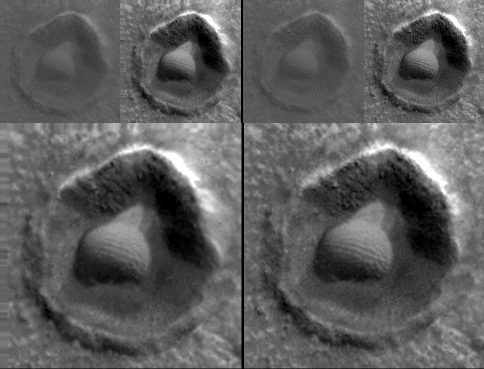
3D Stereo pair analysis of crop from M1501228a by Chris Joseph
3D rendering by of crop from M1501228d by Chris Joseph
© 2001 Christopher Joseph
and Dangerzone Productions
3D Stereo pair of crop from M1501228d by Chris Joseph
© 2001 Christopher Joseph and Dangerzone Productions

3D Stereo Pairing of crop from M1501228d by Chris Joseph
© 2001 Dangerzone Productions
Click here to see the annotated image strip for MOC M15-01228
Crop from annotated image strip of MOC Image M1501228
Image courtesy of Kevin Klettke and
Johnny Danger
© 2001 Dangerzone Productions
If this is an intelligently wrought structure it's origins may be relegated to the depths of antiquity, forever lost along it's secrets and the cultural reasoning for undertaking such an endeavor. Or perhaps not.
Seems to fit pretty nicely, eh?
Be proactive. Make a difference.
Auburn, Washington, USA,
Earth 8\29\2001
Special thanks to the many folks who contributed
to this article and especially to the staff of Danger Team Image Labs:
Kevin Klettke
Al Reaud
Keith Laney
Chris Joseph
J. Danger
Constructive comments
and/or suggestions? Send to Photon's
feedback
Dissenting comments? Send At your own risk to Johnny
Danger's feedback loop